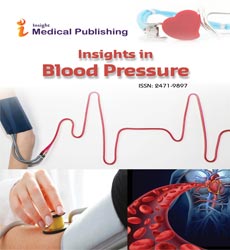A Condition of Spontaneous Intracerebral Haemorrhage and Its Management
Zheng H
Zheng H *
Department of Clinical Research, University of Basel and University Hospital Basel, Basel, Switzerland.
- *Corresponding Author:
- Zheng H
Department of Clinical Research
University of Basel and University Hospital Basel
Basel, Switzerland
Received Date: October 09, 2021; Accepted Date: October 23, 2021; Published Date: October 30, 2021
Citation: Zheng H (2021) A Condition of Spontaneous Intracerebral Haemorrhage and Its Management. Insights Blood Press Vol.7 No.5:3
Commentary
Acute spontaneous intracerebral haemorrhage is a life-threatening condition with a dismal prognosis and few effective treatments that affects people all over the world. As a diverse disease, some clinical and imaging characteristics aid in determining the cause, prognosis, and treatment options. The location, mass effect, and intracranial pressure from the underlying haematoma, as well as subsequent cerebral oedema from perihaematomal neurotoxicity or inflammation, and consequences from prolonged neurological dysfunction, all affect survival and recovery after intracerebral haemorrhage. Active management goals, such as avoiding early palliative care orders, well-coordinated specialist stroke unit care, targeted neurointensive and surgical interventions, early control of elevated blood pressure, and rapid reversal of abnormal coagulation, have a moderate level of evidence supporting them.
Current treatments for intracerebral haemorrhage are ineffective, necessitating novel approaches to improve prognosis. Following the original lesion, a proinflammatory cascade comprising of activated local microglia and astrocytes, as well as infiltrated leucocytes, propagates neural cell death in the perihaematomal zone. Because of the long-term nature of neuroinflammation in intracerebral haemorrhage, there is a window of opportunity for therapy to alleviate the negative repercussions. Several medicines have reduced harmful neuroinflammation in animal models and early clinical trials in intracerebral haemorrhage without compromising the favourable reparative features of an inflammatory response.
After a brain haemorrhage, minocycline, sphingosine-1- phosphate receptor modulators, and statins could be used to control excessively dangerous neuroinflammation. The rapid initiation of these medications, especially in high systemic doses, could be critical in preventing the development of secondary harm in patients with intracerebral haemorrhage. It also offers a promising strategy to combat the dismal prognosis of intracerebral haemorrhage. Intracerebral haemorrhage accounts for one out of every ten strokes, yet it has the worst overall result of any stroke subtype.
The size of the first haematoma is an important prognostic factor, as are early complications including haematoma expansion, obstructive hydrocephalus and perihaematomal oedema - these conditions can make the situation worse. There is evidence that, regardless of premorbid condition or stroke severity, withdrawal of treatment occurs more frequently in intracerebral haemorrhage than in ischemic stroke. Recent research suggests that, in carefully selected instances, anticoagulant reversal, aggressive blood pressure control, and surgery may improve results. Ongoing study could also lead to the development of novel medical therapies and minimally invasive surgical techniques. It can be challenging to effectively apply evidencebased care for intracerebral haemorrhage patients, although quality improvement methodologies can assist in achieving maximum benefit.
Spontaneous intracerebral haemorrhage (ICH) is a deadly type of stroke with a high mortality and morbidity rate for which there are currently no viable treatments. Many experimental and clinical studies have been carried out in order to better understand the mechanisms underlying the ensuing inflammatory cascade and to find viable treatment methods. The goal of this study is to explore clinical discoveries that have led to the development of a number of ICH animal models. The current and future obstacles that clinicians face in understanding ICH are also discussed. Small artery illnesses such as deep perforator arteriopathy (hypertensive arteriopathy) or cerebral amyloid angiopathy are the most common causes of spontaneous non-traumatic Intracerebral Haemorrhage (ICH) (CAA). ICH causes a substantial proportion of stroke mortality and morbidity, although accounting for just 10-15% of all strokes. There are few proven effective acute or preventive therapies.
Intracerebral Haemorrhage (ICH) is a potentially fatal neurologic lesion that affects 10-15% of stroke patients in the United States each year. Age, hypertension, male gender, coagulopathy, and genetic predisposition are all risk factors, It has been determined that he is of European ancestry. Clinicians face a problem in identifying, diagnosing, and managing this ailment in a timely manner since a variety of circumstances can obstruct excellent functional outcomes. Several big clinical studies involving medicinal and surgical procedures have been done in the previous decade. However, no single treatment has been found to have a significant impact on clinical outcomes.
There are now available management guidelines based on medical evidence and consensus, which provide a foundation for care. While hypertension and coagulopathy management are widely regarded core pillars of ICH management, in the emergency context, a number of techniques for surgical hematoma evacuation, intracranial pressure control, and intraventricular haemorrhage might be explored for chosen patients. The intricacy of care in parenchymal cerebral haemorrhage continues to be a challenge, and there are many areas where more research is needed. The background, pathophysiology, and early therapy of spontaneous parenchymal bleeding are all covered in detail.
Open Access Journals
- Aquaculture & Veterinary Science
- Chemistry & Chemical Sciences
- Clinical Sciences
- Engineering
- General Science
- Genetics & Molecular Biology
- Health Care & Nursing
- Immunology & Microbiology
- Materials Science
- Mathematics & Physics
- Medical Sciences
- Neurology & Psychiatry
- Oncology & Cancer Science
- Pharmaceutical Sciences
